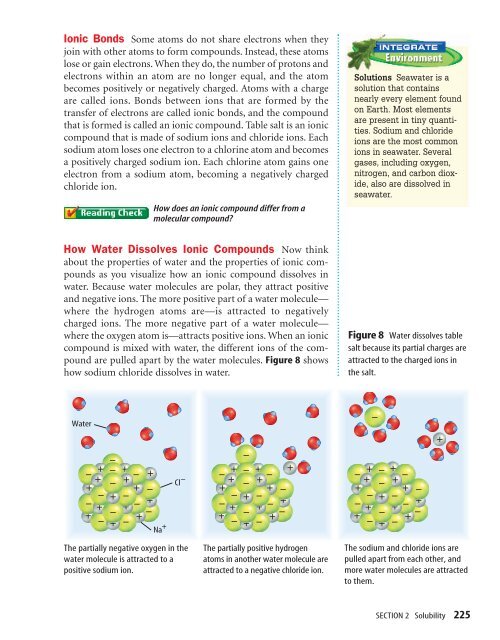Substances, Mixtures, and Solubility - McGraw-Hill Higher Education
Substances, Mixtures, and Solubility - McGraw-Hill Higher Education
Substances, Mixtures, and Solubility - McGraw-Hill Higher Education
Create successful ePaper yourself
Turn your PDF publications into a flip-book with our unique Google optimized e-Paper software.
Ionic Bonds Some atoms do not share electrons when they<br />
join with other atoms to form compounds. Instead, these atoms<br />
lose or gain electrons. When they do, the number of protons <strong>and</strong><br />
electrons within an atom are no longer equal, <strong>and</strong> the atom<br />
becomes positively or negatively charged. Atoms with a charge<br />
are called ions. Bonds between ions that are formed by the<br />
transfer of electrons are called ionic bonds, <strong>and</strong> the compound<br />
that is formed is called an ionic compound. Table salt is an ionic<br />
compound that is made of sodium ions <strong>and</strong> chloride ions. Each<br />
sodium atom loses one electron to a chlorine atom <strong>and</strong> becomes<br />
a positively charged sodium ion. Each chlorine atom gains one<br />
electron from a sodium atom, becoming a negatively charged<br />
chloride ion.<br />
How does an ionic compound differ from a<br />
molecular compound<br />
Solutions Seawater is a<br />
solution that contains<br />
nearly every element found<br />
on Earth. Most elements<br />
are present in tiny quantities.<br />
Sodium <strong>and</strong> chloride<br />
ions are the most common<br />
ions in seawater. Several<br />
gases, including oxygen,<br />
nitrogen, <strong>and</strong> carbon dioxide,<br />
also are dissolved in<br />
seawater.<br />
How Water Dissolves Ionic Compounds Now think<br />
about the properties of water <strong>and</strong> the properties of ionic compounds<br />
as you visualize how an ionic compound dissolves in<br />
water. Because water molecules are polar, they attract positive<br />
<strong>and</strong> negative ions. The more positive part of a water molecule—<br />
where the hydrogen atoms are—is attracted to negatively<br />
charged ions. The more negative part of a water molecule—<br />
where the oxygen atom is—attracts positive ions. When an ionic<br />
compound is mixed with water, the different ions of the compound<br />
are pulled apart by the water molecules. Figure 8 shows<br />
how sodium chloride dissolves in water.<br />
Figure 8 Water dissolves table<br />
salt because its partial charges are<br />
attracted to the charged ions in<br />
the salt.<br />
Water<br />
<br />
<br />
<br />
<br />
<br />
<br />
<br />
<br />
<br />
<br />
<br />
<br />
<br />
<br />
<br />
<br />
<br />
<br />
<br />
<br />
<br />
<br />
Na <br />
Cl <br />
<br />
<br />
<br />
<br />
<br />
<br />
<br />
<br />
<br />
<br />
<br />
<br />
<br />
<br />
<br />
<br />
<br />
<br />
<br />
<br />
<br />
<br />
<br />
<br />
<br />
<br />
<br />
<br />
<br />
<br />
<br />
<br />
<br />
<br />
<br />
<br />
<br />
<br />
<br />
<br />
<br />
<br />
<br />
<br />
<br />
The partially negative oxygen in the<br />
water molecule is attracted to a<br />
positive sodium ion.<br />
The partially positive hydrogen<br />
atoms in another water molecule are<br />
attracted to a negative chloride ion.<br />
The sodium <strong>and</strong> chloride ions are<br />
pulled apart from each other, <strong>and</strong><br />
more water molecules are attracted<br />
to them.<br />
SECTION 2 <strong>Solubility</strong> 225

















